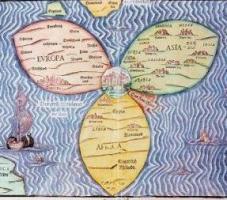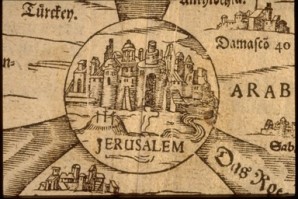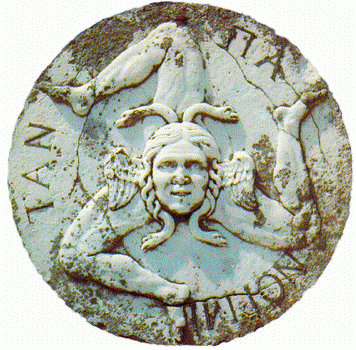Iakov levi
Jan.21, 2008
This
city of
with
other countries round about her. (Ezekiel 5:5)
According to the
bible,
According to a Jewish legend:
The construction of the earth was begun at the centre,
with the foundation stone of the
On the same stone - the very same primal, original matter/mater - the sacrifice of Isaac was attempted. It also constituted
the very altar of the
In the Bible, towns are specifically called "Daughters" (Banot) :
Manasseh had in Issachar and in Asher Beth - shean and its towns (in Hebrew "Bnoteah" = "her daughters"), and Ibleam and its towns (Bnoteah), and the inhabitants of Dor and its towns (Bnoteah), and the inhabitants of En-dor and its towns (Bnoteah), and the inhabitants of Taanach and its towns (Bnoteah), and the inhabitants of Megiddo and its towns (Bnoteah), even the three heights. ( Joshua 17:11)
And "mother", "daughters" and "sisters". So the prophet addresses Jerusalem:
Behold, everyone who uses proverbs shall use [this] proverb against you, saying, As is the mother, so is her daughter. You are the daughter of your mother, who loathes her husband and her children; and you are the sister of your sisters, who loathed their husbands and their children: your mother was a Hittite, and your father an Amorite
Your elder sister is Samaria, who dwells at your left hand, she and her daughters; and your younger sister, who dwells at your right hand, is Sodom and her daughters. Yet have you not walked in their ways, nor done after their abominations; but, as [if that were] a very little [thing], you were more corrupt than they in all your ways. As I live, says the Lord Yahweh, Sodom your sister has not done, she nor her daughters, as you have done, you and your daughters. Behold, this was the iniquity of your sister Sodom: pride, fullness of bread, and prosperous ease was in her and in her daughters; neither did she strengthen the hand of the poor and needy. (Ezekiel 16:46-9)
And Jerusalem is beautiful as a beloved woman: "You are beautiful, my love, as Tirzah, Lovely as Jerusalem. Awesome as an army with banners." (Canticle 6:5)
On "house" as a libidinal object, Shakespeare
enlightened us as well:
Falstaff: "Of what quality was your love,
then?"
Ford: "Like a fair house built upon another man's ground; so that I have
lost my edifice by mistaking the place where I erected it" (Merry Wives of
Winsdor, Act II - Scene II)
The associative link is obvious: love is equivalent to a fair
house.
According to tradition, the founding stone was called Shetyiah,
which in Hebrew also means 'drinking', because beneath it is hidden the source
of all the springs and fountains from which the world drinks its water[6].
Again, the water - maternal symbol and primal source of all life - is mentioned
in association with the foundation stone.
Moreover, the sages of
The Almighty created the world in the same manner as a
child is formed in its mother's womb. Just as a child begins to grow from its
navel and then develops into its full form, so the world began from its central
point and then developed in all directions. The navel of the world is
The three monotheistic religions show this centre of the world (axis mundi, as Mircea Eliade calls it) in different sites within the walls of the Old City (Old City = Old Lady). The Jews see it as the foundation stone. The Christians recognize it in the Omphalos, located in the church of the Holy Sepulchre. The Omphalos (navel of the world) is a stone. The Arabs site it in the Damascus Gate, which they call Baab El 'Amud, which means: Gate of the Column (again an axis mundi). The reason here is that, in Byzantine times at this gate, there was a column from which all the distances in the Empire were measured[8] .
Axis mundi -An Axis is for sure a penis
symbol. A column is the same. Henceforth, stone - navel - uterus - umbilicus and
penis. All in the same condensation. The symbol is interpreted according to the
level of psychosexual organization, from genital back to intra uterine.
AS
I have shown in On Trees and on Birds , a penis symbol may be
interpreted as male or female, Mother or Father, according to the context.
Three - cloverleaf - Medusa
Since


HEINRICH
BÜNTING
Detail:
German, 1545-1606
From: Itinerarium Sacrae Scripturae ...
Woodcut, 25.8 x
Osher Collection
I quote from Jerusalem: The Center of the World
This curious map appeared in a late sixteenth-century rendition of the
Bible in the form of an illustrated travel book. It reflects outmoded medieval
theologic-geographic concepts, placing
The format of the map is an imaginative adaptation of the cloverleaf
design taken from the coat of arms of

The
Tripartite Medusa
Freud has shown that the number 3 is the
symbol of the penis, and that tripartite symbols symbolize the genital:
I should like, however, to devote a few words to one symbol, which , as it were, falls outside this class -- the number 3. Whether this number owes its sacred character to this symbolic connection remains undecided. But what seems certain is that a number of tripartite things that occur in nature- the clover leaf, for instance - owe their use for coats of arms and emblems to this symbolic meaning. Similarly, the tripartite lily - the so called fleur de lis and the remarkable heraldic device of two islands so far apart as Sicily and the Isle of Man - the triskeles (three bent legs radiating from a center) - seem to be the stylized versions of the male genitals[9] .
However, since Freud himself has shown that the little
child is convinced that females possess a penis like his own[10],
when the triskeles , the clover leaf
or the tripartite symbol are associated with a feminine image, it means
that the intention is to symbolize a female penis.
Medusa, a female with snakes as hair - the snake is a
confirmation and repetition of the number 3, i.e. a female penis - is an
instance. (Cf., Three Women: the Penis
and Medusa, the Female Genital and the
Nazis ).
In our unconscious - as in
children mind - the world around is invested by a process of eroticization and
personification. As Freud and Abraham have shown, trees and stones, cities and
landscapes are bodies, bodies' part and sexual organs. We speak of Jerusalem
Jerusalem Jerusalem
The Neturei Karta in Meah Shearim
If I forget you, Jerusalem, Let my right hand forget its skill. Let my tongue stick to the roof of my mouth if I don't remember you; If I don't prefer Jerusalem above my chief joy. ( Psalms 137:5-6)
By night on my bed, I sought him whom my soul loves. I sought him, but I didn't find him. I will get up now, and go about the city; In the streets and in the squares I will seek him whom my soul loves. I sought him, but I didn't find him. The watchmen who go about the city found me; "Have you seen him whom my soul loves?" I had scarcely passed from them, When I found him whom my soul loves. I held him, and would not let him go, Until I had brought him into my mother's house, Into the chamber of her who conceived me. I adjure you, daughters of Jerusalem, By the roes, or by the hinds of the field, That you not stir up, nor awaken love, Until it so desires. (Canticle 3:1-5)
In Jerusalem, not far from the walls of the Old City, in a quarter called Meah Shearim, lives a sect of ultra orthodox Jews. They are called - by themselves and by others - Neturei Karta, that in Aramaic means: "The Keepers of the City".
They are considered the most orthodox sect of Jews. Some consider them not just orthodox but ultra - fanatic.
Well, as beauty is in the eye of the beholder, so is stickiness to an idea, ideology or religion. Speaking of ideologies and religion, if one stands on a peg of a ladder, whoever stands on a higher peg is considered a fanatic and whoever stands on a lower peg is considered an apostate.
What interests us is the substance of this sect. And substance, to me, means psycho sexual level.
In the 19th century, those people set themselves in Jerusalem, and established their settlement as close as possible to the Mount of the Temple and the centre of the emotional life of the nation. At that time the Ottoman rulers of the Land eyed suspiciously at every attempt of Jewish settlement, particularly in the Land's Holy Sites and Jerusalem, which are considered sacred by the Muslims too.
So they settled for a new block, built outside the walls of the Old City. They wanted to be as close as possible to the centre. They stick there, and they consider an apostasy to settle anywhere else. The physical closeness to the most Holy Site is of pivotal importance to them. It is a question of intimacy. Like a little Oedipal child, who is eager to stay attached to his mother gown, and never to be torn from her intimacy.
At difference from other groups of Jews, who began to settle the Land in the same century, they declared themselves as anti - Zionists. Namely they rejected fiercely the idea of political life and nationhood for the Jews in Palestine. The very idea of Jewish independence is to them an idiom for Evil.
In The Exile and its Consequences for Jewish Monotheism I sustained that Zionism represented the collective resurgence of Oedipal lust for the Mother - in its displacement into the Promised Land - and the concomitant rebellion against the Father's rule (religion), which was unconsciously interpreted as inhibiting the return of the Sons to the Mother's body and intimacy.
Therefore, Zionism was born as a political and non - religious movement. In some cases it was interpreted even as anti - religious. Jewish religion and tradition were interpreted as an inhibition of heterosexual lust, and therefore were rejected by the first pioneers - settlers. Later, moderate religious Jews embraced the cause of Zionism too, and became National Religious. That was some sort of compromise and synthesis between the love for the Mother and the acceptance of the Father's rule. The aggressive content toward the Father - peculiar to the Oedipal position - was successfully repressed.
To day most religious Jews are Zionist, and do not see any contradiction in their position. On the contrary, they consider it to be the perfect synthesis for possessing both maternal love and the father's approval. After all, the Torah - another maternal symbol - was given by God to Israel as an act of Love. The same is true for the Promised Land, which was given by God as a sign of his benevolence
Now, we have a sect, which displays no less heterosexual lust for the Mother's body than the Zionists. However, they declare to be anti - Zionists. Furthermore, the Neturei Karta call the Zionists apostates, criminals, and even Nazis. They call names even those Jews who are Zionists and religious. In their eye, if they are Zionists they cannot possibly be good Jews.
Why criminals and Nazis ? Criminals because they dare to rebel to the Father's yoke, and Nazis because the Holocaust was inflicted upon the Jews because of that rebellion. To them, the Holocaust is a punishment by God for apostasy. Henceforth, the true Nazis are the Zionists.
In Jews Hugging and Kissing Ahmadinejad I have shown how and why it occurred that in their eagerness to display their faithfulness and total submission to the rule of the Father - as they interpret them -, those Jews do not hesitate to wish for the destruction of the State of Israel and to allay with its worst enemies. The hint is that they see in a second Holocaust the just punishment for the Zionists'rebellious and aggressive drives. Aggressive drives toward the Father because of Oedipal lust toward the Land.
As we have seen, the Oedipal lust for the female genital, Jerusalem and her holy places, is felt by the Neturei Karta in even a more intensive and uncompromising hysterical way than by the Zionists. The Neturei Karta , who live in Meah Shearim don't even contemplate the possibility of phisically detaching themselves from the Holy Place for a small moment.
One content explains the other. The uncompromising lust explains the uncompromising submission to the rites of the Father. The intensity of the excitement explains the anxiety for the Father's wrath. The more a little Oedipal child feels excited by the proximity of his mother's intimacy, the more he dreads his father's anger. The anxiety and the terror are truthfully expressed in Genesis' verse:
They heard the voice of Yahweh God walking in the garden in the cool of the day, and the man and his wife hid themselves from the presence of Yahweh God among the trees of the garden. Yahweh God called to the man, and said to him, "Where are you?" The man said, "I heard your voice in the garden, and I was afraid, because I was naked; and I hid myself." (Gen. 3:8-10)
Now, because of their sense of guilt, they are compelled to go a long way in trying to persuade their own Super - Ego that not only they completely submit to the Father's will and his rites, to the point of living 25 hours a day in a total neurotic compulsory condition (Freud has shown the perfect correlation between religious rites and obsessive neurotic symptoms), but they also must distance themselves from those who are suspected of harboring the same Oedipal lust - on one hand - but of harboring aggressive drives toward the paternal instance - on the other hand - at the same time.
After all, those suspected aggressive drives are no else than their own. A hostile and bellicose attitude toward the infidels - suspected of harboring the same impulses - is a precondition for maintaining these same aggressive impulses in the repression.
The Neturei Karta in Meah Shearim
If I forget you, Jerusalem, Let my right hand forget its skill. Let my tongue stick to the roof of my mouth if I don't remember you; If I don't prefer Jerusalem above my chief joy. ( Psalms 137:5-6)